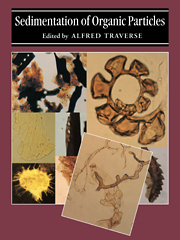Book contents
- Frontmatter
- Contents
- Editor's preface
- List of contributors
- I Introduction
- II Studies of palynosedimentation in modern environments
- 2 The sorting of spores and pollen by water: experimental and field evidence
- 3 Transport and deposition of pollen in an estuary: signature of the landscape
- 4 Pollen preservation in alkaline soils of the American Southwest
- 5 Wind and water transport and sedimentation of miospores along two rivers subject to major floods and entering the Mediterranean Sea at Calvi (Corsica, France)
- 6 Sedimentation of land-derived palynomorphs in the Trinity–Galveston Bay area, Texas
- 7 The genesis and sedimentation of phytoclasts with examples from coastal environments
- 8 Palynofacies of some recent marine sediments: the role of transportation
- 9 Maceral palynofacies of the Louisiana deltaic plain in terms of organic constituents and hydrocarbon potential
- 10 Organic sedimentation in a carbonate region
- 11 An approach to a standard terminology for palynodebris
- 12 Relationships of palynofacies to coal-depositional environments in the upper Paleocene of the Gulf Coast Basin, Texas, and the Powder River Basin, Montana and Wyoming
- III Reconstruction of late Cenozoic vegetation and sedimentary environments from palynological data
- IV Application of data on palynosedimentation to solution of geological problems
- V Appendix
- Index
11 - An approach to a standard terminology for palynodebris
Published online by Cambridge University Press: 06 January 2010
- Frontmatter
- Contents
- Editor's preface
- List of contributors
- I Introduction
- II Studies of palynosedimentation in modern environments
- 2 The sorting of spores and pollen by water: experimental and field evidence
- 3 Transport and deposition of pollen in an estuary: signature of the landscape
- 4 Pollen preservation in alkaline soils of the American Southwest
- 5 Wind and water transport and sedimentation of miospores along two rivers subject to major floods and entering the Mediterranean Sea at Calvi (Corsica, France)
- 6 Sedimentation of land-derived palynomorphs in the Trinity–Galveston Bay area, Texas
- 7 The genesis and sedimentation of phytoclasts with examples from coastal environments
- 8 Palynofacies of some recent marine sediments: the role of transportation
- 9 Maceral palynofacies of the Louisiana deltaic plain in terms of organic constituents and hydrocarbon potential
- 10 Organic sedimentation in a carbonate region
- 11 An approach to a standard terminology for palynodebris
- 12 Relationships of palynofacies to coal-depositional environments in the upper Paleocene of the Gulf Coast Basin, Texas, and the Powder River Basin, Montana and Wyoming
- III Reconstruction of late Cenozoic vegetation and sedimentary environments from palynological data
- IV Application of data on palynosedimentation to solution of geological problems
- V Appendix
- Index
Summary
Introduction
Most palynological investigations start with the maceration of sediments for the removal of their inorganic content. Not only does this separate the palynomorphs but it often leaves a residue of other organic remains which can be studied microscopically as well as chemically. There is great variation in the terms applied to these non-palynomorph remains since most of the people studying them are geologists lacking knowledge of plant anatomy and morphology. Confusing, often misleading and even wrong terms have been given to some broken plant parts. It is the purpose of this chapter to help establish a standard terminology for the microscopist.
Three different approaches are given to the study of these fragments according to the nature of the problems to be investigated and according to the background of the authors:
(1) Coal petrologists (see Brooks, 1981; Durand, 1980) still use versions of Stopes' (1935) terminology for the organic components of macerals. Teichmüller and Teichmüller (1968) related these studies to a morphological approach.
(2) Geochemical studies of kerogen (Crum-Brown, 1912) have recently been summarized by Tissot et al., (1974) and Burgess (1974).
(3) Paleobotanical (including paleopalynological) studies of palynodebris are the central scope of this chapter, and the visual microscopical observations so derived form the basis of these comments on their classification. It attempts to encourage a standard terminology for types of visually observed palynodebris compatible with all facies, and as far as possible to relate these types to a functional sedimentological setting for microscopical use.
- Type
- Chapter
- Information
- Sedimentation of Organic Particles , pp. 199 - 216Publisher: Cambridge University PressPrint publication year: 1994
- 7
- Cited by

